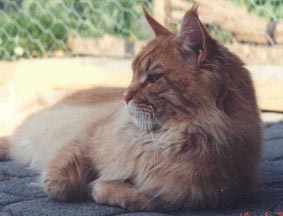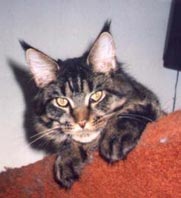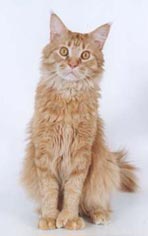By Dortemarie Kaplers

WW 98/2000 & 2001 EC Guldfakse's Chief Two Moons
Breeder: Dortemarie Kaplers
Owners: Susanne & Per Larsen, Sebasco's Maine Coon |
|

( model for MCO2K logo ) |
Breeders are not in complete agreement on how a Maine Coon should look. However, this does not apply specifically to this breed… opinions differ on other races as well. Dortemarie Kaplers in DARAK, Denmark , is an acknowledged specialist on Maine Coon cats and has her own opinion of how they should look. She has bred Maine Coon for many years and has been very successful – also at exhibitions – and many share her view of this beautiful breed, i.e. it should NOT look like a Norwegian Forest Cat!
Background of Dortemarie Kaplers
The first time I heard of and saw the Maine Coon was in 1970, i.e. 8 years before I had my first Norwegian Forest Cat. The only problem was that I really was not interested in cats, I loved dogs, and it was my grandmother who came home from a visit with a friend in Canada and told me of the wonderful cats her friend had. Not at all like other cats, they displayed a much better temperament, were long-coated with bushy tails and came in many different colours. There were 14 of them, all eager to have contact and very affectionate, which made my grandmother think more of a dog's disposition than that of cat.
As mentioned, I took little notice of what she said, but five years after her death in 1977 – during which time I had become an inveterate owner and advocate of Norwegian Forest Cats – I stumbled on her photos from her trip to Canada , and got somewhat of a surprise. The photos portrayed cats which I thought were Norwegian Forest Cats. My hair stood on end for the photos had been placed in two small envelopes, one for each of my children. I wondered whether my grandmother had had supernatural powers? She could not possibly have known that after her death I would have cats looking exactly like the cats of which she had spoken so fondly.
My interest in the Maine Coon had been aroused, and when I went to an exhibition in Berlin in 1982, I was looking forward to seeing the Maine Coon as this was the exhibition at which the FIF was to decide on approval of the breed. Such approval would constitute a change of policy as it had been decided in 19777, when the Norwegian Forest Cat was approved, never to approve the Maine Coon due to its resemblance to the Norwegian Forest Cat. But luckily, this decision was reversed.
I looked at all the Maine Coon cats at the exhibition. They were exquisite, and I have never forgotten just these cats although I could not see the difference between my Norwegian Forest Cats and these Maine Coons. An American breeder there explained it to me in great detail, but it was still difficult.
Some Norwegians and Swedes at the exhibition told me that it really wasn't all that difficult, because if I took all the defects possible on a Norwegian Forest Cat and added them up, well then I'd have a Maine Coon. I believed this for a long time, and many people still do. Unfortunately also some judges do so which does not make things easier.
In the US , I found Maine Coons that looked nothing like Norwegian Forest Cats, which was somewhat of a surprise to me as I had thought that the Maine Coons bred in Europe conformed to the correct standard – this was obviously not the case. To the contrary, I was given the impression that Europe was well on its way to creating a kind of European Coon, which shared few features with the one from Maine
History of the Maine Coon
As is the case with all other natural cats, you can only guess as to how the Maine Coon came into existence. There are numerous legends:
One version, the most romantic, tells of a sailor by the name of Samuel Clough who was given the task of smuggling Marie Antoinette from France to Wiscasset in the US . As you will know, she was instead beheaded, but Captain Clough got her belongings with him to the US , including 6 long-coated cats. These, so the story goes, formed the origins of the Maine Coon cat.
Another sailor by the name of Coon is said to have brought the Angora and Persian cats with him home to the East Coast of the US . When many of the kittens born were long-coated, they were called Coon's cats and later Maine Coons.
I don't think any of this is true, rather the truth is that the Maine Coon was created by a mix of several types of long-coated cats, which the sailors of Maine brought back. These could have been Norwegian Forest cats and Angora cats, but we can only guess. The Maine Coon is simply proof of the theory of survival of the fittest. It is a working cat, equipped to survive even under rough conditions.
In terms of exhibitions, the Maine Coon was popular as early as the 1800's. In 1878, an exhibition in Boston displayed some 10 Maine Coons. In 1895 at Madison Square Garden , a Maine Coon was selected as Best in show. In the early 1920s, the breed disappeared from US exhibitions as the Persian cat and other exotic cats that had come to the country from, among other places, Europe , attracted more interest.
As a result, the Maine Coon faced tough times. In 1959, the breed was declared extinct and in 1973, a newspaper simply stated that the breed did not exist at all. However, it most certainly did, and thanks to persisting breeders, the Maine Coon breeders and Fanciers Association (MCBFA) was founded in 1968. Following this, all US clubs accepted the Maine Coon again, i.e. for approval, registration and with a right to titles.
In the US , there are 5 standards for the Maine Coon, and with FIFé's standard, the number is up to 6. Small wonder, therefore, that confusion arises due to the differences in the way these cats look. The standards are almost the same, but differ on individual points enough to result in a different look. US standards prescribe for example a medium broad and medium long head, slightly longer than it is broad, while the FIF simply states that the head should be broad.
Some standards wish to see large, round and slanting eyes, while some require them to be large and oval, FIF wants hem large and open. CFA requires stooping ears, while other standards require the ears to be straight with a least one ear's width between them.
The Americans themselves say that the wish the Maine Coon standard to accommodate differences because large variations are found in nature. But the basic things must be present, such as the size, the length of the head and body and the quality of the coat.
The state of Maine has declared the Maine Coon its official state cat, and it is certainly considered a national treasure, displayed at every opportunity. At cat exhibitions, the Maine Coon is the second-most exhibited cat, outnumbered only by the Persian cat.
WW95 & `96 EC Maine-Marke´s Dakota |

|
The look of the Maine Coon cat
The Maine Coon is a large, massive and muscular cat, probably the largest of thoroughbred cats. A grown male is impressive, but it should be borne in mind that the Main Coon develops slowly and is not full-grown until it is at least three or four years old. A young male of one or two years has the long body but is often not as broad as broadness develops last. Females are considerably smaller, but although they are often feminine, they must be strongly built.
Compared to the broad head of the Persian and Siamese cats, the Maine Coon has a medium-broad head. However, breeding males aged 3 or more may have very broad heads. Kittens and young cats up to about 1½ year should have a head that is longer than it is broad, as a short head on a young cat always results in a head that is too short when the cat is fully grown. High cheekbones, a square nose and strong jaws characterise a predator. And the Maine Coon is a predator. In order to crush its prey, exactly this part of the head needs to be correct. When I say square nose, I mean square from all angles, and not at all narrow or pointed but more like a matchbox. The chin must be strong and in line with the nose and upper lip, strong enough to be seen from the side but not prominent. The profile is slightly concave with an arched forehead. The nose should not have stops or breaks.
The ears must be large, very coated, broad at the base and pointed with tufs. They are placed high on the head with a fair distance between them. The distance between the ears is growing on breeding males as the head grows broader, but the ears must stand up straight because the predator must be able to hear its prey. If the ears fall down to the side on an adult cat, they have been too far apart from the beginning. This is worth remembering when you look at young cats. The correct placing of the ears on young cats is not very far apart and standing straight up. The Americans themselves emphasise the importance of correct placing of the ears, and call ears that have slid into horizontal position “Aeroplane ears”.
The eyes are large and round, slightly slanting and far apart. The placing gives the cat an owl-like look and the fact that the eyes are slanting does in no way give the cat an oriental look. All eye colours are permitted, matching the colour of the coat.
The body is muscular and medium to large. An adult male has a broad chest, and although a young cat is not yet as broad as required, the legs should be well apart. The body is long and well set up and appears rectangular, equally broad over the shoulders and hips. It is important that the body is in balance, equally heavy front and back. Some of the cats unfortunately have a tendency to become too heavy at the back. The legs must be solid and medium long, matching the body. In fact, the legs are long, but the long coat on the stomach…gives the impression that they are only medium long. The paws are large, round and well-coated. “Snow shoes” are a necessity. With the native population of Maine Coons, polydactly (several toes) is quite common, as actually around 40% of the original Maine Coon cats were poly. As a result, when approval of the cat as a thoroughbred was applied for in the US , two standards were submitted, one for polydactly cats and one for cats with the normal number of toes. However, the applicants were advised that it would be hard enough just to obtain approval of the ordinary cats, and to withdraw the application for the poly cats. They did, but several of the “old” breeders continue to breed poly… cats in the hope that they will be approved within the foreseeable future and thus can be exhibited as a group of their own. It should be emphasised that these cats of course are not involved in the breeding of the ordinary 5/4 toe cats.
MtKittery Socko P
Polydactly (several toes) |

|
I myself own a “poly” and take part in the US breeding programme for these cats. It is a harmless mutation, or defect if you wish, and there is widespread opposition against the project. For me, it is nostalgia or the “mystical past” that is the attraction. Just as when I HAD TO own a Norwegian Forest cat picked up in nature. Working with the “original” cat is very appealing.
The tail is long, broad at the base and pointed. The tail must be as long as the body. The coat is long and wavy with fine underfur covered by long overhairs, which are water-repellent. Short on the shoulders and longer on the stomach and flanks. It is shaggy, i.e. the hairs are of uneven length. The quality is silk-like and shiny. There is a noticeable difference between the structure of the coat of a Norwegian Forest cat and a Maine Coon. I would go as far as to say that if you cannot distinguish the two breeds in any other way, you can feel the difference in the coat, even with your eyes closed. This difference is noticeable also on kittens.
As with other natural cats, their summer and winter coat differs, however, not as much as with the Norwegian Forest cat, which is due of course to the thick underfur of the Norwegian Forest cat, which is fully or partially missing in the Maine Coon. Outdoor and indoor cats also differ, as outdoor cats have a thicker and oilier coat.
The Maine Coon cat comes in all the colours we know from the Norwegian Forest cat. However, colours tend to be more intense, which is probably because the Americans focus a lot on achieving deep, clear colours in the cats, as they are exhibited according to colour.
In terms of temperament, the Maine Coon easily scores 10 out of 10. It is a wonderful cat, quite unbearable as a kitten/young cat. Naughty and directly mischievous, always running about. It is very fast, moves like a gazelle, even when it grows to be large and heavy. A male usually weighs between 6 and 8 kilos, females between 4 and 7 kilos. Of course there are examples of heavier Maine Coons, but they are rare. If you want Maine Coons, you need to provide lots of toys, as they are extremely playful. They thrive very well indoors and get along well with other cats, dogs and even rabbits and other pets. They will want to join in on EVERYTHING you do and love human contact. This makes it difficult to keep them locked up and closed doors are not tolerated.
…… Dortemarie's sketch of how a Maine Coon should look.
This article has kindly been provided by Dortemarie Kaplers, Guldfakse's Maine Coon.
Translated by Karin Barfoed, Blackfeet Maine Coon
|